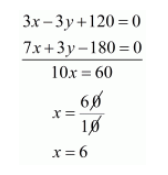$\mathrm{ABCD}$ is a cyclic quadrilateral such that $\angle \mathrm{A}=(4 y+20)^{\circ}, \angle \mathrm{B}=(3 y-5)^{\circ}, \angle \mathrm{C}=(-4 x)^{\circ}$ and $\angle \mathrm{D}=(7 x+5)^{\circ}$. Find the four angles.
We know that the sum of the opposite angles of cyclic quadrilateral is $180^{\circ}$ in the cyclic quadrilateral $A B C D$ angles $A$ and $C$ and angles $B$ and $D$ pairs of opposite angles
Therefore
$\angle A+\angle C=180^{\circ}$ and $\angle B+\angle D=180^{\circ}$
$\angle A+\angle C=180^{\circ}$
By substituting $\angle A=(4 y+20)^{\circ}$ and $\angle C=(-4 x)^{\circ}$ we get
$4 y+20-4 x=180^{\circ}$
$-4 x+4 y+20=180^{\circ}$
$-4 x+4 y=180^{\circ}-20$
$-4 x+4 y=160^{\circ}$
$4 x-4 y=-160^{\circ}$
Divide both sides of equation by 4 we get
$x-y=-40^{\circ}$
$x-y+40^{\circ}=0 \cdots(i)$
$\angle B+\angle D=180^{\circ}$
By substituting $\angle B=(3 y-5)^{\circ}$ and $\angle D=(7 x+5)^{\circ}$ we get
$3 y-5+7 x+5=180^{\circ}$
$7 x+3 y=180$
$7 x+3 y-180=0 \cdots(i i)$
By multiplying equation ![]() by 3 we get
by 3 we get
$3 x-3 y+120^{\circ}=0 \cdots(i i i)$
By subtracting equation (iii) from (ii) we get

By substituting $x=6^{\circ}$ in equation $(i)$ we get
$x-y+40^{\circ}=0$
$6-y+40=0$
$-1 y=-40-6$
$-1 y=-46$

$y=46$
The angles of a cyclic quadrilateral are
$\angle A=4 y+20$
$=4 \times 46+20$
$=184+20$
$=204^{\circ}$
$\angle B=3 y-5$
$=3 \times 46-5$
$=138-5$
$=133^{\circ}$
$\angle C=-4 x^{\circ}$
$=-4(6)$
$=-24^{\circ}$
$\angle D=7 x+5$
$=7 \times 6+5$
$=42+5$
$=47^{\circ}$
Hence the angles of quadrilateral are $\angle A=204^{\circ}, \angle B=133^{\circ}, \angle C=-24^{\circ}, \angle D=47^{\circ}$
